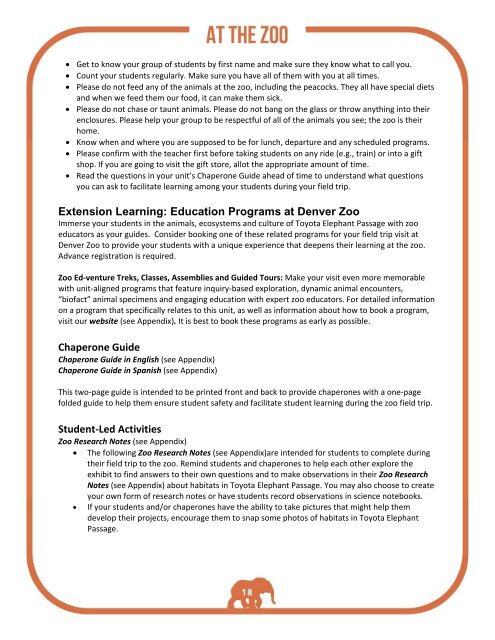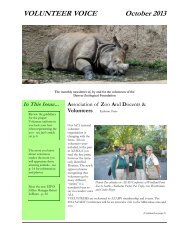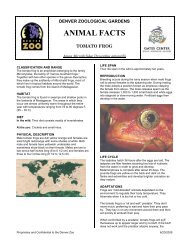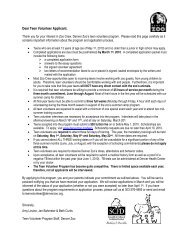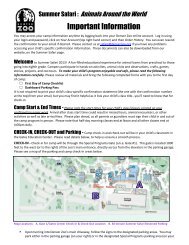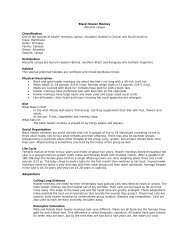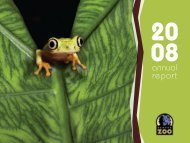Download Printer Friendly PDF - Denver Zoo
Download Printer Friendly PDF - Denver Zoo
Download Printer Friendly PDF - Denver Zoo
You also want an ePaper? Increase the reach of your titles
YUMPU automatically turns print PDFs into web optimized ePapers that Google loves.
Get to know your group of students by first name and make sure they know what to call you. Count your students regularly. Make sure you have all of them with you at all times. Please do not feed any of the animals at the zoo, including the peacocks. They all have special dietsand when we feed them our food, it can make them sick. Please do not chase or taunt animals. Please do not bang on the glass or throw anything into theirenclosures. Please help your group to be respectful of all of the animals you see; the zoo is theirhome. Know when and where you are supposed to be for lunch, departure and any scheduled programs. Please confirm with the teacher first before taking students on any ride (e.g., train) or into a giftshop. If you are going to visit the gift store, allot the appropriate amount of time. Read the questions in your unit’s Chaperone Guide ahead of time to understand what questionsyou can ask to facilitate learning among your students during your field trip.Extension Learning: Education Programs at <strong>Denver</strong> <strong>Zoo</strong>Immerse your students in the animals, ecosystems and culture of Toyota Elephant Passage with zooeducators as your guides. Consider booking one of these related programs for your field trip visit at<strong>Denver</strong> <strong>Zoo</strong> to provide your students with a unique experience that deepens their learning at the zoo.Advance registration is required.<strong>Zoo</strong> Ed‐venture Treks, Classes, Assemblies and Guided Tours: Make your visit even more memorablewith unit‐aligned programs that feature inquiry‐based exploration, dynamic animal encounters,“biofact” animal specimens and engaging education with expert zoo educators. For detailed informationon a program that specifically relates to this unit, as well as information about how to book a program,visit our website (see Appendix). It is best to book these programs as early as possible.Chaperone GuideChaperone Guide in English (see Appendix)Chaperone Guide in Spanish (see Appendix)This two‐page guide is intended to be printed front and back to provide chaperones with a one‐pagefolded guide to help them ensure student safety and facilitate student learning during the zoo field trip.Student‐Led Activities<strong>Zoo</strong> Research Notes (see Appendix) The following <strong>Zoo</strong> Research Notes (see Appendix)are intended for students to complete duringtheir field trip to the zoo. Remind students and chaperones to help each other explore theexhibit to find answers to their own questions and to make observations in their <strong>Zoo</strong> ResearchNotes (see Appendix) about habitats in Toyota Elephant Passage. You may also choose to createyour own form of research notes or have students record observations in science notebooks. If your students and/or chaperones have the ability to take pictures that might help themdevelop their projects, encourage them to snap some photos of habitats in Toyota ElephantPassage.18


